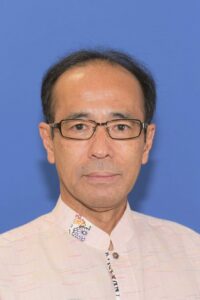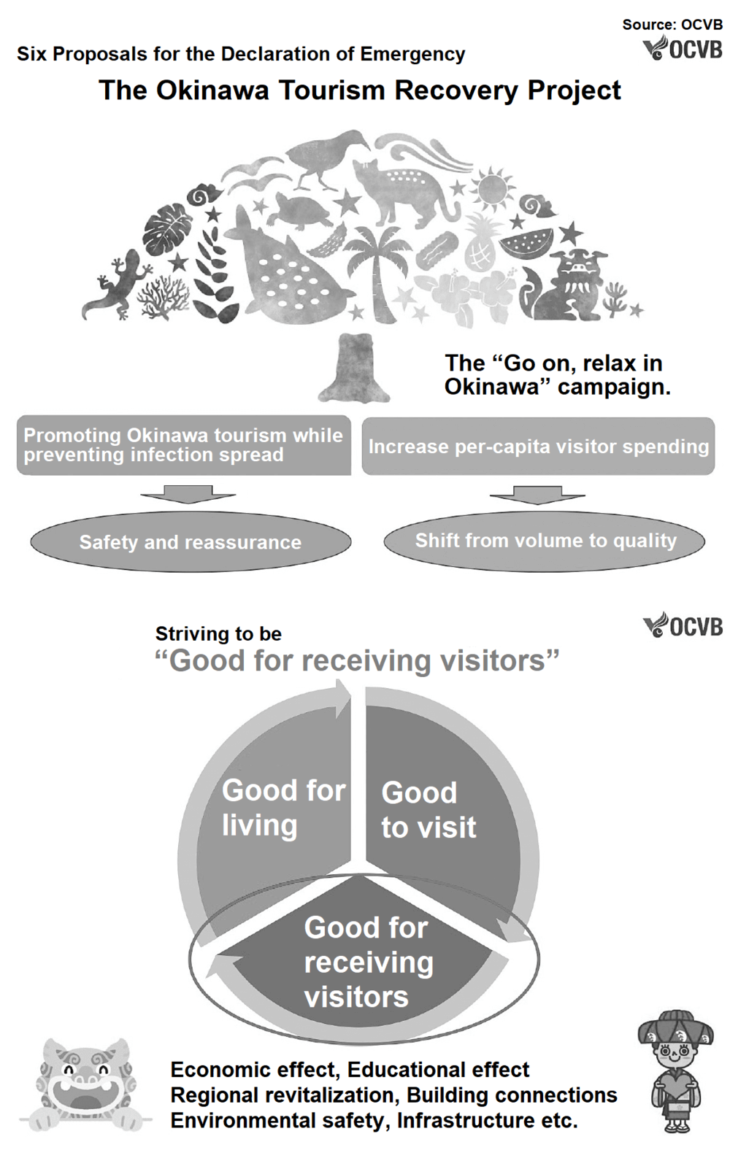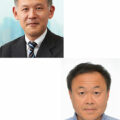What Does “Quality” Mean for Tourism
Shimoji Yoshiro, Chairman of the Okinawa Convention & Visitors Bureau (OCVB)
Interviewed by Yamada Yuichi, General Manager of the Tourism Research Department, Japan Travel Bureau Foundation on October 7, 2020
Developments in Okinawa tourism from spring to September 2020
Yamada Yuichi: Please tell us about developments in Okinawa tourism over the last few months.

Shimoji Yoshiro, Chairman of the Okinawa Convention & Visitors Bureau (OCVB)
Shimoji Yoshiro: There was nothing we could do about the national emergency declaration in April and May, but in June and July when we’d finally started to recover, infection spread in an unexpected place, namely nightlife districts. Okinawa has been susceptible to infectious disease due to our social environment. Historically, we have many children and elderly people who often interact, and this was the case during previous epidemics of new strains of influenza or measles. It is a weakness with no solution and we have gone on with 20 or 30 cases of infection a day.
In July we launched a domestic campaign “Go on, relax in Okinawa” to reinforce the recovery trend that saw visitors gradually increase to 270,000. The intention was to secure the usual summer demand as well as the fall/winter graduation travel market. Then, at the end of October we would promote the recovery of Okinawan and Japan tourism at Tourism EXPO Japan.
Perhaps at some point in July we should have slammed on the brakes, forcibly stopping the flow of people. If we had done so, we may have been able to minimize the spread of the second wave across the country, but we still do not have the answer to this. While the Go To Travel campaign that began in late July was not what we experts in infectious diseases had intended, we all understood that some people could not make ends meet without turning around local economies.
Unfortunately, however, infection increased from the second half of July and Okinawa Prefecture entered its own declaration of emergency period during October. Following strong representations from the tourism industry, as a prefecture we did not request the issuance of advice against traveling to Okinawa from the mainland. Meanwhile, we worked to prevent infection and enable economic recovery. Nevertheless, the end result was that visitor numbers dropped to 200,000. It was an important period for Okinawa to increase income, but income in August was 20% compared with the same month of the previous year, which is a very tough situation.
Yamada: It seems that at one time the Okinawans tended to attribute infections to tourists, but what is their recent attitude to tourism?
Shimoji: For a long time, we in the tourism industry have been strongly urging the prefectural administration to properly analyze and publish not just the number of infections but also details of infection routes. Recently, they have started to publish infection routes such as through dining and medical facilities. I think the April and May impression that “tourists are causing all infection” has weakened considerably. Even when there are cases of the virus being brought in from outside the prefecture, it’s important we properly use statistics to show the steady number of cases emerging among residents and have residents understand that.
 Lately citizens have also come to understand the causes of infection and it’s also true that if we don’t get tourism moving there will be a considerable effect on the prefectural economy. It doesn’t feel as if people are saying “Stop bringing tourists in.” There was some unease over Tokyo being added to the Go To Travel campaign from October, but people are very keen to make up the August losses and I think they’ve started to deal with things in a slightly calmer way.
Lately citizens have also come to understand the causes of infection and it’s also true that if we don’t get tourism moving there will be a considerable effect on the prefectural economy. It doesn’t feel as if people are saying “Stop bringing tourists in.” There was some unease over Tokyo being added to the Go To Travel campaign from October, but people are very keen to make up the August losses and I think they’ve started to deal with things in a slightly calmer way.
When the Okinawa state of emergency was lifted on September 5 the effect would have been minor if OCVB and tourism industry had simply said, “It’s been lifted.” So, we moved to issue a video message from the Okinawa governor to tourists as soon as possible. That had an effect, and three or four days after the lifting we issued positive messages. I feel that having a local leader send out messages at each stage of this coronavirus catastrophe has been particularly effective, and we want to continue with that.
Yamada: Airline companies say they have careful measures to prevent infection within aircraft, but in reality, I don’t think passengers are all that reassured. In effect Okinawa is only accessible by air routes and personally I feel that ANA, JAL and others could cooperate in a slightly different way.
For example, Haneda Airport is mostly not in operation so planes could take off and land at “satellite” airport zones rather than have all the Okinawa flights crowd together. Or they could use international route aircraft (which are also mostly not flying) for two return flights a day to Okinawa and make the seating mainly business class.
That way people wouldn’t be close together, and another incentive would be that they’d experience flying to Okinawa international business class. Even if the planes flew only at busy times for tourists, I think there would be a significant impact and it would catch the attention of the media too.
Shimoji: OCVB has proposed six emergency-operation items to the prefectural government and cooperation between airlines was the first one. As the Go To Travel campaign continues we are fine tuning our efforts so that travelers chose Okinawa, but I think that your suggestion is a very good one.
The problem with setting visitor numbers targets
Shimoji: The current situation is tough but Okinawa has solid tourism infrastructure and services, such as cruise berths and accommodation facilities. Going forward, I think it will be important to make proper plans to further reinforce the quality of three things: our infrastructure, services, and destination management.
During 2019, there was a rapid rise in the number of visitors to Okinawa, so we discussed spreading out demand and raising per-capita spending. These issues are still to be addressed, but the market has suddenly shrunk so it feels like there are even more problems now.
Some in the tourist industry think, “Now we’ve achieved 10 million we should go for 20 million next. Let’s support our economy by increasing the amount of tourism.” On the other hand, more and more people think that, “Considering sustainable development of destinations, we should think more seriously about the balance between quantity and quality in those areas.”
I tend to agree with the latter view, namely that when we reassess the benefits of a “10 million visitor” era for tourists, citizens, the industry, and regions there were serious issues—and that setting even higher targets for visitor numbers is not realistic. We’ve got to a point where we closely examine the nature of outcome indicators. We need to share information on the current situation with everyone, work with a broader range of stakeholders to think about KPI that reflect the right kind of Okinawa tourism, and also discuss what our priorities should be.
Right now, we are at 35.9% of the previous year and 3.6 million visitors are predicted for 2020. If we draw a graph that starts with 77,000 visitors in April and go on the same way, it looks doubtful we will get more than three million, so we have suddenly gone from an era of 10 million visitors to three million.
Although airlines continue to reduce the number of flights, we are cooperating with airlines, travel agencies, and digital companies to get the tourism market moving. If that happens, the outlook won’t be based on the current situation but on how much we can add, so right now at OCVB we are working to produce numerical targets for this and the next financial year.
Expanding the scope of activities to employment measures and business support
Yamada: When you look back at Okinawa tourism over the last few months, please tell us about things you feel are problematic.
Shimoji: Going forwards, I think two things we need are recovery of the market and business support. When it comes to market recovery, key elements are measures to prevent infection and attracting visitors. In particular, school graduation trips and other groups will increase from now on, so we need to further strengthen infection prevention measures at airports and in urban areas. Right now, in Okinawa Prefecture we are making a system that uses LINE to issue notifications about the new coronavirus, and plan to roll it out in October 2020. We aren’t stopping only at superficial safety and reassurance, so we need to combine this with COCOA (COVID-19 Contact-Confirming Application) and reinforce our measures in multiple ways.
In parallel with this, we also need promotions to attract visitors, and we know that at times like this when infectious disease has spread, messages from local administration leaders can be a very effective way to support the market. So, I think that further bolstering communication by the governor is a natural thing for the tourism industry to do. Also, when it comes to PR and promotion, I think that we must use this situation to boost digitally-focused initiatives.
Regarding business support, OCVB doesn’t have its own scheme, so we have asked relevant national and prefectural organizations to offer support. With such a drop in the number of tourists, we can expect it to be very hard for companies in the prefecture to support employment. As well as measures to help the already unemployed find new jobs, I think we should impress on the prefecture the need for measures to help people switch to different kinds of employment. Inbound tourism is also likely to be tough until 2021 and in some ways it will be hard to sustain existing types of employment, so those kinds of measures are likely to be necessary.
During previous crises we were able to get by with separate measures such as support for healthcare systems during the SARS epidemic in 2003 and financial support during the 2001 terror attacks in the United States. But Okinawa tourism has never faced such a serious situation and now we need to do it all. Tourism measures to date were based on attracting and receiving visitors, but I think they are now more closely connected to things like business support, employment measures and coordination with healthcare policy.
Yamada: When we talk about handling both business support and coordination with healthcare, as an organization how much can OCVB do and at what point does it become difficult?
Shimoji: There is scope for action by OCVB itself and scope for action together with the authorities, but cooperation with healthcare is very important when it comes to coronavirus measures. Our healthcare-related initiatives are centered on the Traveler’s Access Center Okinawa (TACO) at Naha Airport, while as a rule our dealings with local authority healthcare offices are via the local authority tourism office. If we did anything else, the line of command would become disconnected. We relay voices from the ground to the healthcare office via the tourism office and responses come back via the same route, so it takes quite a lot of time.
On the other hand, we have our own network that includes the medical association and highly knowledgeable doctors such as Takayama Yoshihiro of the Division of Infectious Diseases at Okinawa Chubu Hospital, so I think we are starting to link tourism and healthcare on the ground.
We are telling staff that we can’t get through this crisis just by continuing our previous work. We say that OCVB’s own income has decreased, and that a different role is required from before, so they need to respond to the situation. Nevertheless, I recognize that it’s very hard for staff.
Also, when it comes to promotional activity, to date the role of OCVB has been to focus on visitors from abroad and outside the prefecture. But during this coronavirus catastrophe an important topic has emerged: that of boosting tourism from within the prefecture. We serve as a point of contact for a campaign targeting Okinawans called “Okinawa-SaiHakken (Rediscover the colors of Okinawa).” In Hokkaido they separate tourists into “from within Hokkaido” and “from outside Hokkaido,” but Okinawa has “from other parts of Japan” and “overseas.” As we consider future tourism, we need to firmly establish stimulation of the tourism market from within Okinawa as part of OCVB’s work.
Yamada: If Okinawans travel within Okinawa to the extent they have so far, I think that fear and distrust of tourism will weaken. It’s precisely because they see it as a world that’s nothing does to with them that strong feelings arise. Japanese destination marketing organizations (and not just in Okinawa) have focused their energy on marketing outside their regions and they haven’t been very good at domestic marketing, so that has probably become their Achilles heel now.
Towards infrastructure that makes healthcare tourism and tourism healthcare
Yamada: Rather than OCVB and healthcare being one organization talking to another organization, we are gradually building a network of personal connections between experts. In that sense, I believe that Okinawa Prefecture has progressed further than anywhere in Japan with linking healthcare and tourism. An important feature of that, I think, is how epidemiologists like Dr. Takayama don’t negate tourism but talk from a standpoint of thinking about risk.
Shimoji: Dr. Takayama told me something I felt was important. He said that “Alongside the growth in tourism, Okinawa’s healthcare started to deal with heatstroke and accidents among domestic tourists. And these last few years it has also dealt with illness among the increasing numbers of inbound tourists. Healthcare has functioned as part of tourism infrastructure.” He also told me that “In a situation like this where the healthcare system may collapse, I would be grateful if the tourist industry can think of itself as part of healthcare infrastructure.”
For example, it would be good if the prefecture’s tourism industry could put its hand up and each hotel provide ten rooms to be on standby for when hospitals are in a crisis. But there is a risk of tourists being infected and staff lack expert knowledge so in reality they can’t respond and are in a dilemma.
I’m being idealistic, but one example would be for newly-built hotels to set apart several rooms for managing crises, or clinics in airports could be organized in a different way to regular healthcare facilities. In order to make Okinawa tourism stronger I think we have to start asking whether our structures to receive visitors are set up with an awareness of infectious disease or not.
Yamada: For example, it might be good for hotels to consider that an extension of having barrier-free rooms. As a basic principle, healthcare service capacity is determined on the basis of population, and so far, no matter the number of tourists, the Ministry of Health, Labour and Welfare hasn’t taken that into consideration. But in the future, it may be necessary to change to a system of calculation based on regional population plus social infrastructure.
Considering the future sustainability of tourist areas, we may also need to establish an accommodation tax for tourists in a similar way to a municipal tax for residents. Then tourists will take on some of a broadly distributed burden of providing funding for social infrastructure.
Shimoji: The corona catastrophe happened just as debate over the accommodation tax started to resolve in a particular direction, but it’s not just something accommodation providers need to think about. Personally, I’d like that debate to continue among a broad range of stakeholders. It’s not something we can do immediately, but I’d like to keep an eye on the situation then thoroughly address it again.
Thinking about “quality” and tourism in the “30 million era”
Yamada: I believe you are saying that when Okinawa tourism returns to the “30 million era,” and when demand also returns, we should not return to the old path but go back and take a wiser direction. What practical measures do you think we should take?
Shimoji: During this coronavirus catastrophe a pressing issue for the prefecture is to collect data and promote digitalization that can help prevent infection, and it is something that all stakeholders would like. One more topic for when demand returns is how to disperse tourism to different areas, and I think use and application of digital data can suggest various answers here too.
On the other hand, returning to fundamentals means improving the quality of tourism human resources and lifting the social position of the tourism industry. The coronavirus catastrophe has affected people who work in accommodation, dining and souvenir shops more than anyone. In order to improve those people’s, pay and motivate them in their work the industry has to increase revenue. To do that everyone has to aim for a tourism industry that secures reasonable profits. Selling things cheaply as a short-term tactic only creates negative effects for staff.
And these days customers aren’t only asking for cheap things. More and more there’s a sense of looking for things that meet needs, even if expensive, and for safety and reassurance. I think one important point is to extend growth based on that kind of market.
Yamada: In Hawaii, tourism is structured so that when the number of tourists increases worker salaries also increase. But in Okinawa and elsewhere we see a tendency for labor productivity to decrease in areas where inbound tourism has grown. These last few years we’ve been unable to get out of a vicious circle where the more tourist numbers have increased the more there’s been a rush to lower prices, and where employers try to acquire labor at the lowest possible price. If we return to the way things were, the tourism industry will indefinitely remain a harsh industry with low wages.
In that sense, the present high operating ratio of accommodation taking part in the Go To Travel campaign is not a bad thing. People have realized that if they work to attract customers there is demand, so it’s a question of how we can use that going forward.
Developing human resources capable of operating and managing businesses is important for Okinawa. There’s a need for them to understand the fundamentals of accounting and other things, and unless we start with that change labor productivity won’t increase. If Okinawans can set up and manage businesses themselves, that will lead to other things. Looking at that from a different perspective, I think that developing human resources and supporting businesses in order to improve the right figures could also serve as a way to deal with unemployment in the prefecture over the next two or three years until demand recovers.
Shimoji: To date tourism has been a labor intensive industry that uses lots of people. It employs people and quickly gets them into the workplace, but it has been somewhat poor at employing and training staff with high-level skills in marketing, ICT, HR management, and other important areas. Going forward, it’s a question of whether or not we can escape from that. If the tourism industry becomes a high-quality industry that seeks out highly developed knowledge and skills it can have costs and prices to match. When it comes to evaluating the tourism industry, links with universities are important. In response to this coronavirus pandemic, I think we must consider what kind of human resources development we ought to have.
Reprinted from the interview “Tokushu 1: Korona-ka ni okeru, Okinawa notorikumi: Towareru kanko no ‘shitsu’ (Special Feature 1 How Okinawa is Dealing with the COVID-19 pandemic: What Does ‘Quality’ Mean for Tourism)” Kanko Bunka, No. 247 November 2020, pp. 14-17 (Courtesy of Japan Travel Bureau Foundation) [March 2021]
Keywords
- Shimoji Yoshiro
- Okinawa Convention & Visitors Bureau
- OCVB
- Yamada Yuichi
- Japan Travel Bureau Foundation
- Okinawa
- tourism
- COVID-19
- “Go on, relax in Okinawa”
- infection routes
- COCOA
- Go To Travel
- Okinawa-SaiHakken (Rediscover the colors of Okinawa)
- healthcare tourism




